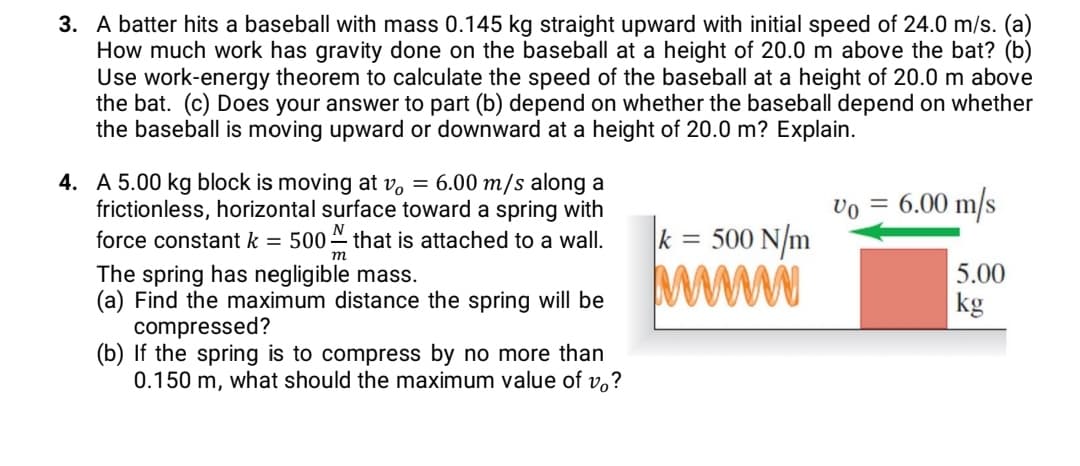3. A batter hits a baseball with mass 0.145 kg straight upward with initial speed of 24.0 m/s. (a) How much work has gravity done on the baseball at a height of 20.0 m above the bat? (b) Use work-energy theorem to calculate the speed of the baseball at a height of 20.0 m above the bat. (c) Does your answer to part (b) depend on whether the baseball depend on whether the baseball is moving upward or downward at a height of 20.0 m? Explain.
3. A batter hits a baseball with mass 0.145 kg straight upward with initial speed of 24.0 m/s. (a) How much work has gravity done on the baseball at a height of 20.0 m above the bat? (b) Use work-energy theorem to calculate the speed of the baseball at a height of 20.0 m above the bat. (c) Does your answer to part (b) depend on whether the baseball depend on whether the baseball is moving upward or downward at a height of 20.0 m? Explain.
Glencoe Physics: Principles and Problems, Student Edition
1st Edition
ISBN:9780078807213
Author:Paul W. Zitzewitz
Publisher:Paul W. Zitzewitz
Chapter10: Work, Energy And Machines
Section: Chapter Questions
Problem 80A
Related questions
Question
Answer for number 3

Transcribed Image Text:3. A batter hits a baseball with mass 0.145 kg straight upward with initial speed of 24.0 m/s. (a)
How much work has gravity done on the baseball at a height of 20.0 m above the bat? (b)
Use work-energy theorem to calculate the speed of the baseball at a height of 20.0 m above
the bat. (c) Does your answer to part (b) depend on whether the baseball depend on whether
the baseball is moving upward or downward at a height of 20.0 m? Explain.
4. A 5.00 kg block is moving at v, = 6.00 m/s along a
frictionless, horizontal surface toward a spring with
6.00 m/s
= 500 N/m
force constant k = 500 that is attached to a wall.
т
The spring has negligible mass.
(a) Find the maximum distance the spring will be
compressed?
(b) If the spring is to compress by no more than
0.150 m, what should the maximum value of v,?
5.00
kg
Expert Solution
This question has been solved!
Explore an expertly crafted, step-by-step solution for a thorough understanding of key concepts.
This is a popular solution!
Trending now
This is a popular solution!
Step by step
Solved in 5 steps

Knowledge Booster
Learn more about
Need a deep-dive on the concept behind this application? Look no further. Learn more about this topic, physics and related others by exploring similar questions and additional content below.Recommended textbooks for you

Glencoe Physics: Principles and Problems, Student…
Physics
ISBN:
9780078807213
Author:
Paul W. Zitzewitz
Publisher:
Glencoe/McGraw-Hill

An Introduction to Physical Science
Physics
ISBN:
9781305079137
Author:
James Shipman, Jerry D. Wilson, Charles A. Higgins, Omar Torres
Publisher:
Cengage Learning

Principles of Physics: A Calculus-Based Text
Physics
ISBN:
9781133104261
Author:
Raymond A. Serway, John W. Jewett
Publisher:
Cengage Learning

Glencoe Physics: Principles and Problems, Student…
Physics
ISBN:
9780078807213
Author:
Paul W. Zitzewitz
Publisher:
Glencoe/McGraw-Hill

An Introduction to Physical Science
Physics
ISBN:
9781305079137
Author:
James Shipman, Jerry D. Wilson, Charles A. Higgins, Omar Torres
Publisher:
Cengage Learning

Principles of Physics: A Calculus-Based Text
Physics
ISBN:
9781133104261
Author:
Raymond A. Serway, John W. Jewett
Publisher:
Cengage Learning

University Physics Volume 1
Physics
ISBN:
9781938168277
Author:
William Moebs, Samuel J. Ling, Jeff Sanny
Publisher:
OpenStax - Rice University

Physics for Scientists and Engineers, Technology …
Physics
ISBN:
9781305116399
Author:
Raymond A. Serway, John W. Jewett
Publisher:
Cengage Learning

Physics for Scientists and Engineers: Foundations…
Physics
ISBN:
9781133939146
Author:
Katz, Debora M.
Publisher:
Cengage Learning